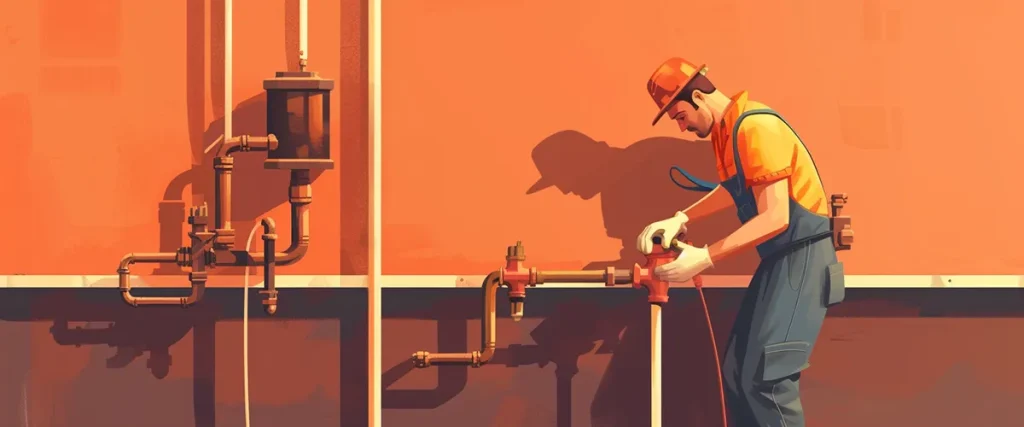Plumbing issues are a common headache for homeowners, with statistics showing that nearly 10% of homes have leaks that waste 90 gallons or more per day. Tackling simple plumbing tasks yourself can save you time, money, and the hassle of scheduling a professional. Think of your home’s plumbing system as the circulatory system of your house; just like blood flows through veins, water flows through pipes. With a little knowledge and the right tools, you can keep this system running smoothly. This DIY plumbing guide will walk you through beginner-friendly DIY plumbing projects, providing step-by-step instructions, necessary tools, safety tips, troubleshooting advice, and when to call a professional.
Beginner-Friendly DIY Plumbing Projects
Fixing a Leaky Faucet
A leaky faucet is a common issue that can be easily fixed with basic tools, making it an ideal DIY plumbing project for beginners.
Steps:
- Identify the Faucet Type: Determine whether you have a compression, ball, cartridge, or ceramic-disk faucet, as the repair process varies.
- Gather Tools: You will need a wrench, screwdriver, replacement parts (such as washers or O-rings), and plumber’s tape.
- Turn Off Water Supply: Before starting, shut off the water supply to prevent any mess.
- Disassemble the Faucet: Carefully remove the faucet handle and other components to access the faulty part.
- Replace the Damaged Part: Swap out the worn washer or O-ring with a new one, ensuring a proper fit to stop the leak.
- Reassemble and Test: Put the faucet back together and turn on the water supply to check for leaks.
This project not only saves money but also helps in understanding the basic mechanics of plumbing systems.
Unclogging Drains
Clogged drains are another frequent plumbing issue that can be tackled with a DIY approach.
Steps:
- Use a Plunger: A plunger can often dislodge minor clogs in sinks or toilets. Ensure a tight seal and use firm, consistent pressure.
- Apply a Drain Snake: For stubborn clogs, a drain snake can reach deeper into pipes. Insert the snake into the drain and rotate it to break up the blockage.
- Try a Natural Solution: Pour a mixture of baking soda and vinegar down the drain, followed by hot water, to clear minor clogs without harsh chemicals.
This project is straightforward and requires minimal tools, making it perfect for beginners in DIY plumbing.
Replacing a Showerhead
Replacing a showerhead is a simple project that can enhance your shower experience and is a great introduction to DIY plumbing.
Steps:
- Select a New Showerhead: Choose a model that fits your needs, whether it’s a high-pressure, water-saving, or multi-function showerhead.
- Remove the Old Showerhead: Use a wrench to unscrew the existing showerhead. If it’s stuck, apply some lubricant to loosen it.
- Clean the Threads: Before installing the new showerhead, clean the pipe threads and wrap them with plumber’s tape to ensure a tight seal.
- Install the New Showerhead: Screw the new showerhead onto the pipe by hand, then tighten it slightly with a wrench.
This project is quick and requires minimal effort, making it ideal for those new to plumbing tasks.
Important Safety Tips and Precautions
- Turn Off Water Supply: Always turn off the water supply before starting any plumbing project.
- Use Proper Tools: Ensure you have the correct tools for the job to avoid damaging fixtures.
- Wear Protective Gear: Use gloves and safety goggles to protect yourself from debris and chemicals.
- Check for Leaks: After completing a project, check for leaks to prevent water damage.
- Follow Manufacturer Instructions: When using replacement parts, follow the manufacturer’s instructions for installation.
Troubleshooting Common Issues
- Persistent Leaks: Double-check all connections and ensure parts are correctly installed.
- Clogs That Won’t Clear: Consider using a chemical drain cleaner as a last resort, but be cautious of potential pipe damage.
- Low Water Pressure: Clean aerators or showerhead nozzles to remove mineral buildup.
When to Seek Professional Assistance
- Complex Plumbing Issues: If you encounter issues beyond your skill level or comfort, such as major leaks or sewer line problems.
- Repeated Failures: If DIY plumbing attempts repeatedly fail, it may indicate a more serious underlying problem.
- Code Compliance: For projects requiring permits or code compliance, such as major renovations or installations.
FAQs
Q: How often should I check for leaks in my home?
A: It’s a good idea to check for leaks every few months, especially in areas like under sinks and around toilets.
Q: Can I use chemical drain cleaners for clogs?
A: While effective, chemical drain cleaners can damage pipes over time. Use them sparingly and follow instructions carefully.
Q: What should I do if I accidentally damage a pipe?
A: Turn off the water supply immediately and call a professional plumber to assess and repair the damage.
Q: Are there any plumbing tasks I should never attempt myself?
A: Avoid tasks involving gas lines, major sewer issues, or any project requiring permits unless you are experienced.
Conclusion
Tackling simple plumbing tasks can be empowering and cost-effective. By following this guide, you can address common plumbing issues in your home with confidence. Remember to prioritize safety, use the right tools, and know when to call a professional. Share your DIY plumbing project experiences with friends and family, and encourage them to try their hand at these beginner-friendly tasks. Happy plumbing!



